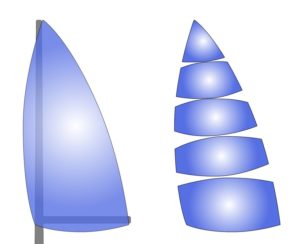Hi,
I thought about posting these 306 questions separately but didn't want to spam the forum. We've had our boat for 2 years now and, between frequent Covid lockdowns here in Melbourne, we are totally in love with the boat. As a floating weekender and comfortable and manageable inshore/coastal cruiser it's a perfect fit for the two of us. Questions for the brains trust here:
Lee Helm. We have in-mast furling, and while it's a great convenience that we'd not give up, I have suspected that these fractional rigs that expect a big paunchy mainsail are perhaps not as well suited to the inevitable in-mast furling sail shape as mast head rigs. The lee helm is very "soft" and not a big issue, but I wondered if I'm missing some tricks to get more power from the main and balance the boat better. The headsail doesn't seem to be oversize and the tell tales on both sails set well, we just find the wheel position is off centre by about 15 degrees when sailing to windward. If I let go, the boat will gradually drift off.
Motor rev range (2GM20F) and hull speed. The throttle cable moves easily from forward idle to 2000rpm then stiffens up considerably. I can then push it hard which gets me to about 2800rpm and just over 5 knots across the ground (across the tide) with our 14 x 10 fixed 3 blade prop. Then the throttle cable hits another "wall" that I've not been game to push it through. The local marina mechanic has assured me that all is "fine" a couple of times, just as car mechanics seem to tell you just before something breaks, but I'm not convinced. So, a couple of questions here. First, is the throttle pressure normally "graded" at all, or has it simply worn itself into a groove where the previous owner liked motoring at less than 2,000 rpm. And second, if the 306 hull speed is around 6.9 knots, what rpm should I normally expect to use to achieve that (or do I have the wrong prop size)?
Waste Tank. On the past couple of occasions when emptying the tank, the indicator will only go down as far as about 20%. The marina assures me their pump is fine and I've not seen any pressure leaks in the fitting or hose. Do you have any particular cleaning ritual that you follow to keep the sensor and tank free of build up or paper debris. It doesn't get a heavy duty work out (that's what marina toilets are for!).
Thanks for any insights or wisdom you can provide!
Cheers, Robert
Charisma, 2004 Hunter 306
Melbourne, Australia
I thought about posting these 306 questions separately but didn't want to spam the forum. We've had our boat for 2 years now and, between frequent Covid lockdowns here in Melbourne, we are totally in love with the boat. As a floating weekender and comfortable and manageable inshore/coastal cruiser it's a perfect fit for the two of us. Questions for the brains trust here:
Lee Helm. We have in-mast furling, and while it's a great convenience that we'd not give up, I have suspected that these fractional rigs that expect a big paunchy mainsail are perhaps not as well suited to the inevitable in-mast furling sail shape as mast head rigs. The lee helm is very "soft" and not a big issue, but I wondered if I'm missing some tricks to get more power from the main and balance the boat better. The headsail doesn't seem to be oversize and the tell tales on both sails set well, we just find the wheel position is off centre by about 15 degrees when sailing to windward. If I let go, the boat will gradually drift off.
Motor rev range (2GM20F) and hull speed. The throttle cable moves easily from forward idle to 2000rpm then stiffens up considerably. I can then push it hard which gets me to about 2800rpm and just over 5 knots across the ground (across the tide) with our 14 x 10 fixed 3 blade prop. Then the throttle cable hits another "wall" that I've not been game to push it through. The local marina mechanic has assured me that all is "fine" a couple of times, just as car mechanics seem to tell you just before something breaks, but I'm not convinced. So, a couple of questions here. First, is the throttle pressure normally "graded" at all, or has it simply worn itself into a groove where the previous owner liked motoring at less than 2,000 rpm. And second, if the 306 hull speed is around 6.9 knots, what rpm should I normally expect to use to achieve that (or do I have the wrong prop size)?
Waste Tank. On the past couple of occasions when emptying the tank, the indicator will only go down as far as about 20%. The marina assures me their pump is fine and I've not seen any pressure leaks in the fitting or hose. Do you have any particular cleaning ritual that you follow to keep the sensor and tank free of build up or paper debris. It doesn't get a heavy duty work out (that's what marina toilets are for!).
Thanks for any insights or wisdom you can provide!
Cheers, Robert
Charisma, 2004 Hunter 306
Melbourne, Australia




